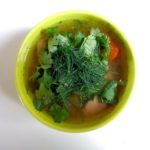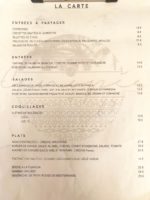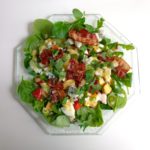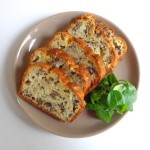 This spring in Paris has seen a great profusion of white asparagus. It came onto the market in early March, ahead of the green variety, and at prices so tempting I couldn’t resist. This, plus a request from a Japanese cooking student, has sparked my creativity this season. I have served white asparagus many times, with a wide variety of sauces. For the delicate flavor of this versatile vegetable can be complemented in many ways.
This spring in Paris has seen a great profusion of white asparagus. It came onto the market in early March, ahead of the green variety, and at prices so tempting I couldn’t resist. This, plus a request from a Japanese cooking student, has sparked my creativity this season. I have served white asparagus many times, with a wide variety of sauces. For the delicate flavor of this versatile vegetable can be complemented in many ways.
Asperges blanches / White asparagus
Opinions differ on white asparagus, but the French generally consider it a greater delicacy than the green variety. Its white color stems from the fact that it is grown underground. It is generally available only during the spring. In terms of preparation, the main difference between white and green asparagus is that the white spears must be peeled. This is not a major conundrum, however. A light touch with a vegetable peeler will do the trick.
And now to the sauces. The asparagus shown in the photo above is adorned with a sauce of crème fraîche, lemon juice, salt, pepper and chives that I invented in my kitchen (well, perhaps someone thought of this before, but I’ve never seen a recipe). It is light and fresh, and marries well with the asparagus without overwhelming it.
 Another sauce I invented combines sesame oil, lemon juice and salt. It is shown here on asparagus spears that have been cut into segments and piled up for an elegant starter. The asparagus is sprinkled with toasted sesame seeds, drizzled with the sauce and topped with fronds of fresh cilantro.
Another sauce I invented combines sesame oil, lemon juice and salt. It is shown here on asparagus spears that have been cut into segments and piled up for an elegant starter. The asparagus is sprinkled with toasted sesame seeds, drizzled with the sauce and topped with fronds of fresh cilantro.
If you’d like to go for a more classic combination, serve white asparagus with mustard vinaigrette, balsamic vinaigrette or, the princess of sauces, hollandaise. For an egg-based sauce that is far easier to prepare than hollandaise, you could try another of my springtime creations, a ‘mimosa’ sauce made of a minced soft-boiled egg mixed with olive oil and lemon juice. (This sauce came about on a country Sunday when we had a leftover soft-boiled egg after breakfast. As they say, or as Frank Zappa might say, necessity is the mother of invention.)
Moving on, some restaurant news. Le Monde ran a big article this week on the revival in Paris of old-fashioned bistros — places that serve old-fashioned dishes like blanquette de veau, oeufs durs mayonnaise and … white asparagus, and where red-and-white checked tablecloths, bread baskets and pyrex glassware hark back to an earlier era. The author attributes the trend to a quest in our complex era for l’authentique (the authentic), which he goes on to rename le fauxthentique, (a play on the word ‘false’), for of course we can never recapture the true nature of what used to be.
One restaurant highlighted in the article is Aux Bons Crus, a bistro located near the town hall of the 11th arrondissement. I dined there recently with a friend and would have to say the false comes through more strongly than the true. The place has all the touches of an old-fashioned bistro — chalkboard menus, retro decor, etc. — but the food did not live up to the reputation, or my memories, of classic French cooking in days gone by.
 What the article did not mention is another trend in Paris, of young chefs putting a modern spin on classic dishes. The latest such establishment to open is JJ, a very contemporary bistro located, I am extremely happy to say, right downstairs from my apartment. It is run by two friends — John, the British-born chef, and Jérémie, who takes care of the front of the house — and the cooking is absolutely inspired. For example, at a private opening last weekend, they offfered a delicate, creamy carrot soup with cockles and herbs (to die for), foie gras with hazelnuts and a foamy morel appetizer served in a small cup.
What the article did not mention is another trend in Paris, of young chefs putting a modern spin on classic dishes. The latest such establishment to open is JJ, a very contemporary bistro located, I am extremely happy to say, right downstairs from my apartment. It is run by two friends — John, the British-born chef, and Jérémie, who takes care of the front of the house — and the cooking is absolutely inspired. For example, at a private opening last weekend, they offfered a delicate, creamy carrot soup with cockles and herbs (to die for), foie gras with hazelnuts and a foamy morel appetizer served in a small cup.
I am looking forward to visiting JJ as often as possible. They have a lunchtime menu priced at 20 euros for two courses or 22 euros for three, and the place, which opened on Tuesday, is already packed. As time goes on, I hope to be able to offer you an Everyday French Chef rendition of some of their creations. And in the meantime…
Happy cooking.
 The subtle flavors of lamb, barley, carrots and gentle spices combine to make a soup that is both satisfying and light, perfect for taking the chill off now that cooler days are arriving at last. Topped with fresh cilantro and dill, with a touch of lemon juice and cinnamon for zest, it evokes the exotic tastes of Central Asian cuisine. I concocted it at lunchtime one gray day this week — a welcome change from the sweltering weather of July.
The subtle flavors of lamb, barley, carrots and gentle spices combine to make a soup that is both satisfying and light, perfect for taking the chill off now that cooler days are arriving at last. Topped with fresh cilantro and dill, with a touch of lemon juice and cinnamon for zest, it evokes the exotic tastes of Central Asian cuisine. I concocted it at lunchtime one gray day this week — a welcome change from the sweltering weather of July.
 There’s a wildness to the combined flavors of figs, garlic and mint that I find absolutely irresistible when fresh figs appear in farmers’ markets in midsummer. Add some tender leaves, olive oil and a spritz of balsamic vinegar, and you have a palate-pleasing summer salad that can be ready in a couple of minutes. This salad marries well with proscuitto-style ham or with goat cheese on toast. I tried it both ways during the recent heatwave.
There’s a wildness to the combined flavors of figs, garlic and mint that I find absolutely irresistible when fresh figs appear in farmers’ markets in midsummer. Add some tender leaves, olive oil and a spritz of balsamic vinegar, and you have a palate-pleasing summer salad that can be ready in a couple of minutes. This salad marries well with proscuitto-style ham or with goat cheese on toast. I tried it both ways during the recent heatwave. Tapenade
Tapenade Poulet au miel et au thym
Poulet au miel et au thym Charlotte glacée aux framboises
Charlotte glacée aux framboises I discovered this dish at a beachside restaurant near Sète in the south of France, and found it so delicious that I asked the chef for the recipe. It is a trilogy of shellfish — mussels, clams and razor clams — that are cooked until just tender and then coated in a persillade sauce of parsley, garlic and olive oil. The recipe is simple, quick and fun to make. The combination, redolent of sun and sea, will knock your socks off.
I discovered this dish at a beachside restaurant near Sète in the south of France, and found it so delicious that I asked the chef for the recipe. It is a trilogy of shellfish — mussels, clams and razor clams — that are cooked until just tender and then coated in a persillade sauce of parsley, garlic and olive oil. The recipe is simple, quick and fun to make. The combination, redolent of sun and sea, will knock your socks off. The restaurant in question,
The restaurant in question,  This classic American salad has taken Paris by storm in recent years, although the French have a way of doing things slightly differently. You will never see iceberg lettuce in a French Cobb, and instead of the traditional sweet dressing it will be served with a tangy mustard vinaigrette. The French also don’t worry about lining up the toppings in rows — they prefer to scatter the chicken, tomatoes, avocado, eggs and bacon over a bed of greens.
This classic American salad has taken Paris by storm in recent years, although the French have a way of doing things slightly differently. You will never see iceberg lettuce in a French Cobb, and instead of the traditional sweet dressing it will be served with a tangy mustard vinaigrette. The French also don’t worry about lining up the toppings in rows — they prefer to scatter the chicken, tomatoes, avocado, eggs and bacon over a bed of greens. We’ve got one week left of spring, time enough to get creative with one of my favorite seasonal fruits — rhubarb. Well, to be exact, it’s a veggie, but for culinary purposes rhubarb stars in desserts. This simple, flavor-packed compote can be prepared in 15 minutes. I like to serve it with a dollop of something creamy on top, for example fromage blanc or Greek yogurt. Add a leaf of mint or a strawberry and it makes an elegant finale to any old meal.
We’ve got one week left of spring, time enough to get creative with one of my favorite seasonal fruits — rhubarb. Well, to be exact, it’s a veggie, but for culinary purposes rhubarb stars in desserts. This simple, flavor-packed compote can be prepared in 15 minutes. I like to serve it with a dollop of something creamy on top, for example fromage blanc or Greek yogurt. Add a leaf of mint or a strawberry and it makes an elegant finale to any old meal. I also grew rhubarb at my country place, and as it is perennial the new owners will also enjoy it. Ah yes, my friends, I sold the dacha this week. It’s a major life change, but one that was necessary. I will miss my garden, but will look forward to creating dishes from all of the fabulous garden-grown fruits and veggies on offer in France.
I also grew rhubarb at my country place, and as it is perennial the new owners will also enjoy it. Ah yes, my friends, I sold the dacha this week. It’s a major life change, but one that was necessary. I will miss my garden, but will look forward to creating dishes from all of the fabulous garden-grown fruits and veggies on offer in France. It’s lunchtime, a guest is coming, you’re in a rush. The omelette mixte is a classic of French cuisine that can be whipped up in just 10 minutes, from eggs, ham and grated Comté or a similar cheese. But, you may be thinking, what’s so special about a ham and cheese omelet? Well, mes amis, the art is in the making — the gentle lifting of the edges to create a fluffy concoction, the flick of the wrist to fold the omelet over itself, French style.
It’s lunchtime, a guest is coming, you’re in a rush. The omelette mixte is a classic of French cuisine that can be whipped up in just 10 minutes, from eggs, ham and grated Comté or a similar cheese. But, you may be thinking, what’s so special about a ham and cheese omelet? Well, mes amis, the art is in the making — the gentle lifting of the edges to create a fluffy concoction, the flick of the wrist to fold the omelet over itself, French style. The origins of beef Stroganoff are murky but the consensus seems to be that a French chef had something to do with it. I therefore offer you my version of this classic dish of thinly sliced beef and mushrooms in a tangy cream sauce. I was inspired to make it recently after a visiting Russian friend, to my great surprise, asked for the recipe. Further inspiration came from an expert on Russian cuisine who is in Paris doing research for a new book.
The origins of beef Stroganoff are murky but the consensus seems to be that a French chef had something to do with it. I therefore offer you my version of this classic dish of thinly sliced beef and mushrooms in a tangy cream sauce. I was inspired to make it recently after a visiting Russian friend, to my great surprise, asked for the recipe. Further inspiration came from an expert on Russian cuisine who is in Paris doing research for a new book. Gorgonzola and walnuts, rigatoni and cream, topped by arugula — a perfect dish for a rainy May in Paris. They say April is the cruelest month, but this is not the case in my city. After a couple weeks of sunshine, summery temperatures and chestnuts in blossom, we are back to raincoats and sweaters. Given the weather, a comforting dish of pasta seemed in order the other day, and this recipe came to mind. I whipped it up in 20 minutes.
Gorgonzola and walnuts, rigatoni and cream, topped by arugula — a perfect dish for a rainy May in Paris. They say April is the cruelest month, but this is not the case in my city. After a couple weeks of sunshine, summery temperatures and chestnuts in blossom, we are back to raincoats and sweaters. Given the weather, a comforting dish of pasta seemed in order the other day, and this recipe came to mind. I whipped it up in 20 minutes. readers of this site will know, is one of my favorites. If you also enjoy Roquefort, recipes you might like to try include
readers of this site will know, is one of my favorites. If you also enjoy Roquefort, recipes you might like to try include  This spring in Paris has seen a great profusion of white asparagus. It came onto the market in early March, ahead of the green variety, and at prices so tempting I couldn’t resist. This, plus a request from a Japanese cooking student, has sparked my creativity this season. I have served white asparagus many times, with a wide variety of sauces. For the delicate flavor of this versatile vegetable can be complemented in many ways.
This spring in Paris has seen a great profusion of white asparagus. It came onto the market in early March, ahead of the green variety, and at prices so tempting I couldn’t resist. This, plus a request from a Japanese cooking student, has sparked my creativity this season. I have served white asparagus many times, with a wide variety of sauces. For the delicate flavor of this versatile vegetable can be complemented in many ways. Another sauce I invented combines sesame oil, lemon juice and salt. It is shown here on asparagus spears that have been cut into segments and piled up for an elegant starter. The asparagus is sprinkled with toasted sesame seeds, drizzled with the sauce and topped with fronds of fresh cilantro.
Another sauce I invented combines sesame oil, lemon juice and salt. It is shown here on asparagus spears that have been cut into segments and piled up for an elegant starter. The asparagus is sprinkled with toasted sesame seeds, drizzled with the sauce and topped with fronds of fresh cilantro. What the article did not mention is another trend in Paris, of young chefs putting a modern spin on classic dishes. The latest such establishment to open is
What the article did not mention is another trend in Paris, of young chefs putting a modern spin on classic dishes. The latest such establishment to open is  A Russian friend was coming over for a cooking lesson. He wanted to learn to make easy dishes he could prepare ahead of time to serve when friends came for supper at his dacha. Top of his list was … beef stroganoff. I found the idea of teaching beef stroganoff to a Russian to be rather fanciful, so I suggested poulet bonne femme, an earthy dish of chicken, bacon, mushrooms and onion that, like stroganoff, is finished with cream.
A Russian friend was coming over for a cooking lesson. He wanted to learn to make easy dishes he could prepare ahead of time to serve when friends came for supper at his dacha. Top of his list was … beef stroganoff. I found the idea of teaching beef stroganoff to a Russian to be rather fanciful, so I suggested poulet bonne femme, an earthy dish of chicken, bacon, mushrooms and onion that, like stroganoff, is finished with cream.

